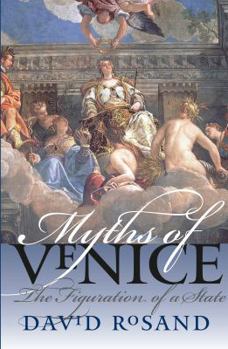Myths of Venice: The Figuration of a State
(Part of the Bettie Allison Rand Lectures in Art History Series)
Select Format
Select Condition 
Book Overview
Over the course of several centuries, Venice fashioned and refined a portrait of itself that responded to and exploited historical circumstance. Never conquered and taking its enduring independence as a sign of divine favor, free of civil strife and proud of its internal stability, Venice broadcast the image of itself as the Most Serene Republic, an ideal state whose ruling patriciate were selflessly devoted to the commonweal. All this has come to...
Format:Paperback
Language:English
ISBN:0807856630
ISBN13:9780807856635
Release Date:August 2005
Publisher:University of North Carolina Press
Length:216 Pages
Weight:0.66 lbs.
Dimensions:0.5" x 6.0" x 9.1"
Related Subjects
Art Art History Arts, Music & Photography Design Europe History History & Criticism Humanities ItalyCustomer Reviews
1 rating
Iconography of the Venetian State
Published by Thriftbooks.com User , 22 years ago
Functioning modern states have their own myths, stories (historical or otherwise) that illustrate the shared communal values that the state is believed to embody and wishes to project (to citizens and foreigners alike). For Renaissance Venice, the myth was that of the Most Serene Republic, built on a perfect foundation of justice, peace and the rule of law, established as the Christian heir to pagan Rome and protected by the saints. In this brief, elegant book, David Rosand shows how richly that political myth was embodied in the public art of the Venetian state, focusing on the paintings and sculpture of the Doge's Palace, the Loggetta of the Campanile, the Libreria di San Marco, and various of the scuola grande. Rosand does a superb job of teasing out all of the multi-layered mythological meanings and allusions present in individual works and in the relationship of one work (or even one building) to another. He also shows that these meanings, although not transparent to most visitors today, were easily understood by educated Venetians and foreigners (and recorded in their diaries and descriptions of the city) throughout the Renaissance. I saw many things that I had not seen before, and will go back to these works with a new appreciation of their meaning and function.This is not art criticism or art appreciation (there is barely a mention of anyone's technique or of aesthetic issues), it's real art history. Rosand's goal is to show how the artwork he considers functioned to both present the Venetian state's self-image and to persuade viewers to accept that image. Given Venice's important role as an early example of a modern state (one that viewed the state itself as an abstract concept, separate from the ruler, who is himself subject to the rule of law), we can still learn much from the methods that Venice used to envision and market itself.Rosand writes for an educated audience, but is readily accessible to non-scholars. He assumes a fair degree of familiarity with Venice -- if you do not know the Piazza from the the Piazzetta, or which facade of the Palace is the south one, you will occasionally find yourself confused. Nor does he stop to explain in any detail the Venetian constitution or the organization of Venetian society. This is a book to take with you on your second or third trip to Venice, or to read while planning such a trip. It does not pretend to be comprehensive, but will give you a real insight into one of the many beautiful threads that make up this complex city.




